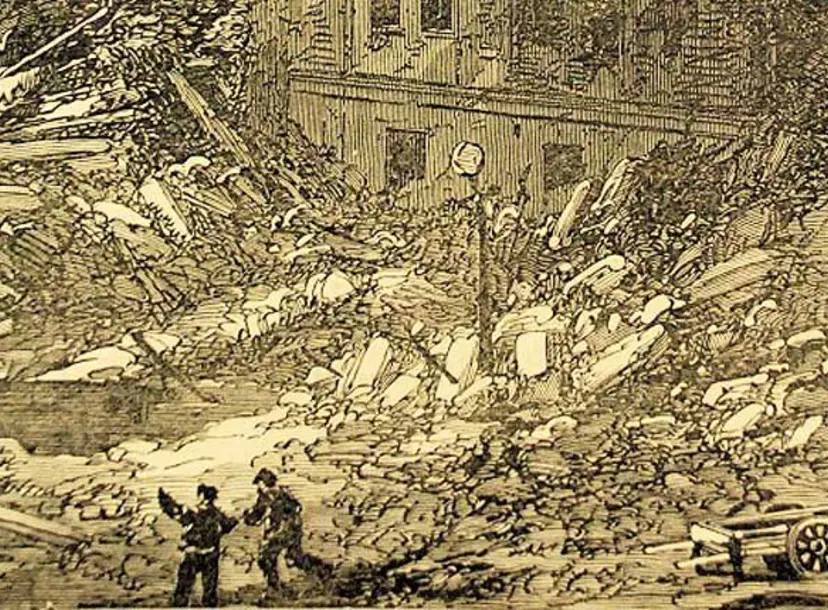Transporting gunpowder
The mining and engineering industries in the 19th century relied heavily on gunpowder as an explosive to aid their work. However, storing and transporting gunpowder on wooden sailing ships was problematic due to its volatile nature. To help mitigate disaster, copper sheeting was used to seal the magazines of gunpowder deep within the hull of a ship.
1843 marked a new era in transportation, the Royal Navy were beginning to replace wooden ships with steamships, and Brunel's steamer 'Great Britain' had launched. Steamships had many benefits for trade, such as speed, but unfortunately, they also presented new issues when moving explosives due to overheating.
Arthur Howe Holdsworth (1780 -1860), a Devon merchant, presented a new method of preventing gunpowder explosions at sea to the Ri. The method relied on cooling steamships to render their powder-magazine fireproof. It’s not clear whether his invention ‘a cooling water jacket’ was widely used, but the 1843 Repertory of Patent Inventions shows it was timely innovation.
Faraday links dust to disasters
Mines were a particularly hazardous working environment during the 1800s. The invention of The Davy lamp in 1815 at the Ri, had already provided a safe source of light for miners without the fear of explosion. However, mining was still dangerous, and after an accident at Haswell Colliery, Durham in 1844, which killed 95 people including children, an investigation was launched. Scientist and founder of the CHRISTMAS LECTURES Michael Faraday, was tasked with uncovering the causes behind such disasters at the inquiry.
After an investigation, Faraday attributed the explosion to a dusty atmosphere caused by coal. He explained how coal dust could lead to explosions in a talk he gave called 'The Condition and Ventilation of the Coal-Mine ‘Goaf’. Incidentally the word 'Goaf' also refers to the empty cavern or the waste left in old mines.
‘Some disturbance of the goaf-cavity… and possibly a change of the pressure of the atmosphere, diffused the fire-damp through the workings at that place. This, when lighted, would, by the explosion, raise, and then kindle the coal-dust which is always abundantly pervading the passages; and these effects must, in a moment, have made the part of the mine, which was the scene of the calamity, to glow like a furnace…’
This was the first-time explosions had been linked to dust. Faraday demonstrated how dust produced an explosion and how ventilation could prevent it.
‘He filled a glass vessel (which represented the goaf cavity) with inflammable air, smoke &c. and then exhausted it in a few seconds, by means of a pipe communicating with the flue of one of the furnaces in the theatre.’ – The Athenaeum
Abel highlights human error
The danger of dust in other industries was largely ignored. In 1872, there was a dust explosion at a Glasgow flour mill which killed 18 people. Frederick Abel, Faraday’s successor as Chemistry Lecturer at the Royal Military Academy and Chemist to the War Department, spoke about dust explosions in 1882.
‘The origin of the explosion was conclusively traced to the striking of fire by a pair of millstones, through the stopping of the feed, and the consequent friction of their bare surfaces against each other; the results being, the ignition of the mixture of air and fine flour-dust by which the millstones were surrounded, and the rapid communication of flame.’
Many explosions were due to workers lack of knowledge on safety issues. In 1875 and 1882 Abel lectured on accidental explosions.
‘The explosion occasioned by a person employing a lighted candle to search for a gas escape in a room where there is a powerful odour of gas or a gunpowder explosion resulting from the dropping of a spark into an open powder barrel from a candle which is held over it should properly have as little claim to be called accidental as a boiler explosion occasioned by a person tying down the safety valve.’
He launched into the causes of numerous boiler explosions which were common in the age of steam, colliery, domestic gas and petroleum explosions.
‘Again, at an ammunition factory, at Birmingham, where an explosion, not long since, resulted in the deaths of fifty three women, it was brought to light during the inquest that there were open stoves, not even provided with fenders, in the middle of the sheds in which the powder work was carried on; at these stoves the women used to cook their dinners, and they were also in the habit of shaking the grains of powder off their aprons into the stoves...’
The Government Acts
After investigations into many fatal incidents and their causes, the Government passed the Explosives Act in 1875. This meant those manufacturing, keeping, storing, carrying, and importing explosive substances were made to adhere to rules for safety reasons. To help prevent further accidents in the workplace the 1878 Factory Act allowed inspectors to insist on ventilation within factories, however. It did not cover mines. Abel appealed for less dust to be created in mines, by fracturing the coal seams with expanding cement.
Sadly during this time some industries were far more dangerous to work in then others. However, thankfully the work of scientists during this period proved to be significant in helping to prevent more explosive disasters.
Laurence Scales leads London tours featuring the history of science, invention and medicine. He is a graduate in engineering who has worked in various technological industries.
